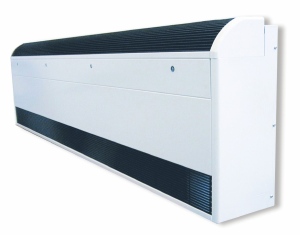Top of the class

David Perry of Xpelair looks at the importance of indoor air quality (IAQ) in schools and what to consider made when specifying ventilation systems in the education sector.
We spend more than 90% of our time indoors and, whilst there is a global understanding of outdoor air pollution, many of us are oblivious to the quality of air we breathe in our own homes, place of work or schools. Indoor air can, in fact, be as much as 50 times more polluted than outdoor air.
Nowhere is this more important, of course, than in schools, where children spend almost one fifth of their week indoors. Indoor air quality in school buildings is affected by outdoor air pollution, operation and management practices — even the building itself.
One of the biggest causes of poor IAQ in any commercial building are pollutants called volatile organic compounds (VOCs). Impossible to detect by human senses, they are naturally emitted from a host of everyday items, including furniture, carpets, paints, varnishes, cleaning products and even the building fabric and materials – especially when new.
At unacceptable levels, VOCs can be harmful to health. Long-term exposure can aggravate pre-existing health conditions such as asthma and eczema, or cause fatigue, rhinitis, dizziness, headaches coughing and sneezing.
All this is compounded in some schools by industrial pollution from surrounding properties or traffic pollution from adjacent main roads — all at risk of entering the building through windows, doors, or even ventilation systems if air-filtration measures are inadequate.
Meeting legislation
Effective ventilation is key to ensuring good IAQ, and there are stringent guidelines in place to ensure effective ventilation in schools.
In addition to meeting Part F (ventilation) and Part L (conservation of fuel and power) of the Building Regulations, ventilation systems in schools and educational buildings must meet the guidelines of DfES ‘Building Bulletin 101, ventilation of school buildings’ and in the ‘Education (school premises)’, which sets out the building regulations for the construction of schools.
Building Bulletin 101 clearly states a number of requirements for any ventilation system in school buildings.
• Natural ventilation should provide a minimum of 3 l/s per person, minimum daily average of 5 l/s per person, and have the capability of achieving 8 l/s per person at any occupied time.
• Mechanical ventilation should provide a minimum daily average of 5 l/s per person, and have the capability of achieving 8 l/s per person at any occupied time.
• The average concentration of carbon dioxide should not exceed 1500 parts per million (ppm). The maximum concentration of carbon dioxide should not exceed 5000 ppm during the teaching day. At any occupied time, the occupants should be able to reduce the concentration of carbon dioxide to 1000 ppm by introducing fresh air at a rate of 8 l/s per person.
It may sound like a challenge, but armed with an understanding of the issue, not to mention a wide range of modern energy-efficient systems from leading manufacturers, there is no reason why engineers can’t deliver the right solution.

Specification success
In many cases, the choice will come down to one (or a combination) of three ventilation system types, each with their own advantages and limitations.
• Natural ventilation
• Mixed mode ventilation
• Mechanical ventilation with energy recovery
Natural ventilation refers to large openings that rely on either buoyancy created by a temperature difference and/or pressure differences created by wind pressure to achieve the desired airflow rates all year round — often enhanced by a stack effect on the building roof.
Despite noise ingress, the potential of draughts (particularly in winter) and the reliance on external conditions to maintain IAQ, natural ventilation remains popular — but there is no opportunity to recover energy between the outgoing and incoming air.
Mixed-mode ventilation (such as Xpelair’s Classmate) uses passive means when the external conditions are sufficient to satisfy IAQ requirements, but has fans to boost the input ventilation when required. This gives automatic control of IAQ all year round, reduces the need for large openings in summer if fans are used, and gives schools to opportunity to factor in acoustic treatment on input to combat noise ingress.
The third solution, mechanical ventilation with energy recovery (MVER), is by far the most reliable and the most efficient.
By enabling schools to recover energy between the outgoing and incoming air, MVER can ensure air quality at all times, tempering inlet air and preventing draughts. Recovering up to 90% of energy in the outgoing stale air offers energy-efficient operation and more than offsets the fan power required to run the system. There is a host of added benefits, including ducted supply to improve air distribution and comfort.
Thanks to continued innovation and improved performance from ventilation manufacturers, specifiers have access to a host of high-efficiency high-performance solutions designed to meet the demands of modern schools. But only those who do their homework will come top of the class for indoor air quality.
David Perry is national sales manager with Xpelair.







